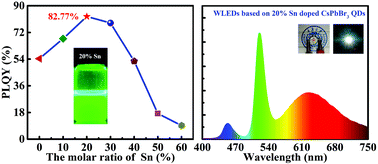Room temperature synthesis of Sn2+ doped highly luminescent CsPbBr3 quantum dots for high CRI white light-emitting diodes†
Abstract
With a high photoluminescence quantum yield (PLQY) being able to exceed 90% for those prepared by the hot injection method, CsPbBr3 quantum dots (QDs) have attracted intensive attention for white light-emitting diodes (WLEDs). However, the whole process is carried out in a 3-neck flask via air isolation and at a relatively high temperature. In addition, CsPbBr3 QDs suffer from poor stability under ambient atmosphere. In this work, an effective strategy through doping of Sn2+ ions at room-temperature is proposed to improve the emission efficiency and stability of CsPbBr3 QDs. Compared with pure CsPbBr3 QDs, a higher PLQY and a better stability are obtained. The detailed physical mechanism for this performance enhancement is discussed and described. An optimum result is found at an Sn2+ doping amount of 20%, which shows a high PLQY of 82.77%. WLEDs based on these 20% Sn2+ doped CsPbBr3 QDs are also studied, exhibiting a high color rendering index of 89 and a correlated color temperature (CCT) of 3954. The method proposed here provides an effective strategy to enhance the fluorescence and stability of CsPbBr3 QDs, which might have promising potential in the lighting fields.

- This article is part of the themed collection: Quantum Dots: A Nanoscience Nobel Prize


 Please wait while we load your content...
Please wait while we load your content...